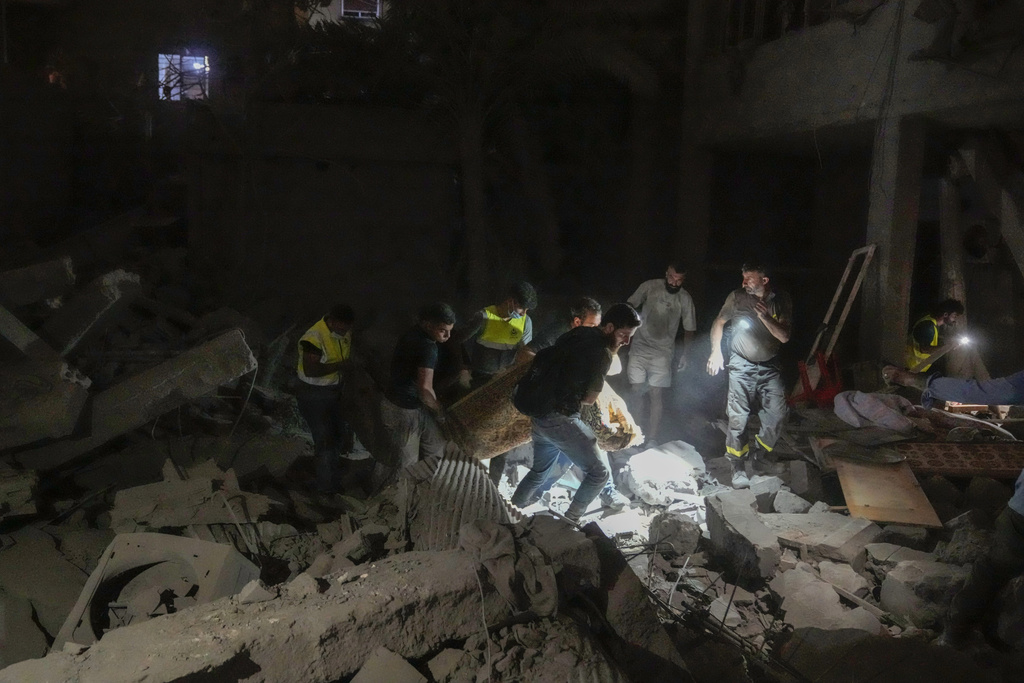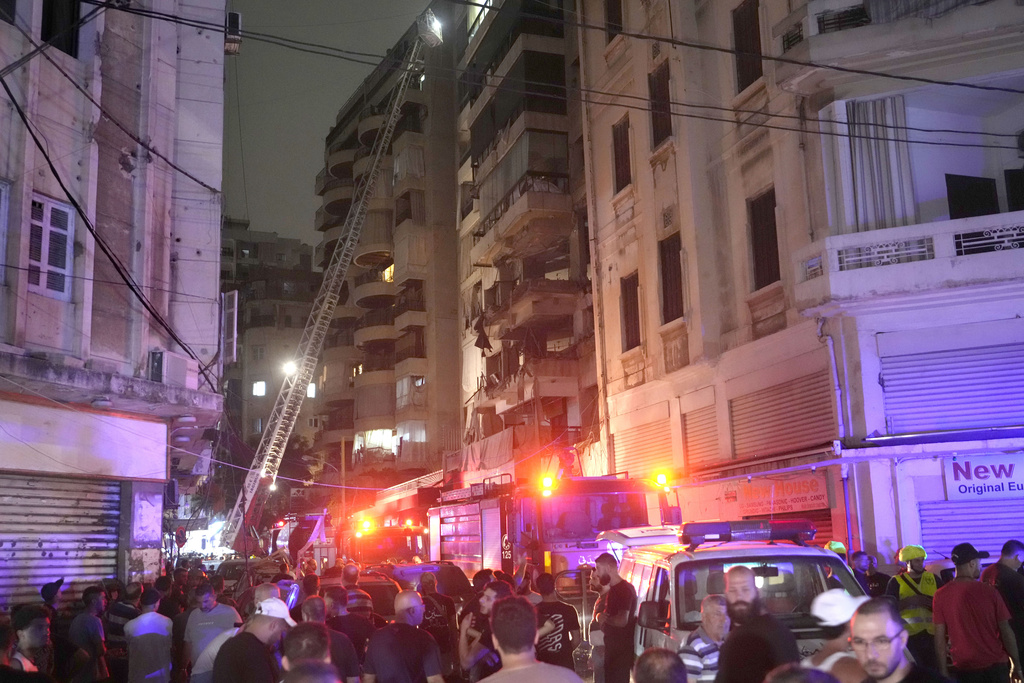Israeli Airstrikes in Central Beirut Kill 11, Injure 48 Amid Conflict \ Newslooks \ Washington DC \ Mary Sidiqi \ Evening Edition \ Israeli airstrikes targeted central Beirut on Thursday, killing at least 11 people and wounding 48, according to Lebanon’s health ministry. The strikes, which hit two densely populated areas, resulted in buildings collapsing and severe casualties. This escalation comes as Israel continues military operations against Hezbollah in Lebanon, along with ongoing strikes in Gaza. Earlier in the day, an Israeli strike in Gaza killed 27 people, including civilians sheltering in a school. The conflict, now stretching across two fronts, shows no sign of de-escalation as both sides continue to suffer heavy losses.

Israeli Airstrikes on Central Beirut: Quick Looks
- Death Toll and Injuries: 11 killed and 48 wounded in Israeli airstrikes on central Beirut’s Ras al-Nabaa and Burj Abi Haidar neighborhoods.
- Collapsed Buildings: Massive damage reported; entire buildings collapsed, fires burned after the strikes.
- Israeli Response: No immediate statement from the Israeli military, though such strikes in central Beirut are rare.
- Gaza Strikes: Earlier strikes in Gaza killed at least 27, including civilians in a school sheltering displaced people.
- UN Attack: Israeli tank fire on a U.N. peacekeeping base in southern Lebanon injured two peacekeepers, drawing condemnation.
- Ongoing Conflict: Over 2,100 killed in Lebanon since the war erupted, with civilian casualties mounting on both sides.
Deep Look:
In an escalation of the already volatile conflict, Israeli airstrikes targeted central Beirut on Thursday evening, killing at least 11 people and wounding 48 others, according to the Lebanese health ministry. The strikes hit two densely populated neighborhoods—Ras al-Nabaa and Burj Abi Haidar—leaving buildings in ruins, fires raging, and rescue efforts underway as ambulances rushed to the scene.
The first strike, in the Ras al-Nabaa district, hit the lower half of an eight-story apartment building, where explosions continued to erupt after the initial impact, possibly due to fires or secondary detonations. An Associated Press photographer at the scene described chaos, with emergency responders trying to navigate through the wreckage as civilians were pulled from the rubble. The area, a largely residential neighborhood, had not been a regular target of Israeli airstrikes before.
The second strike in Burj Abi Haidar was even more devastating. An entire building collapsed, trapping an unknown number of residents inside. The building was engulfed in flames, with rescue workers and firefighters battling to control the fire and reach survivors. Eyewitnesses described hearing screams for help as teams worked against time to clear the debris. For many, the shock was compounded by the fact that these strikes had targeted central Beirut, far from the typical conflict zones in southern Lebanon, where Israel has focused much of its military operations in recent weeks.
No Immediate Israeli Military Statement
While Israel has frequently launched strikes against Hezbollah positions in Beirut’s southern suburbs, such attacks in central Beirut are unusual. There was no immediate comment from the Israeli military on the strikes. The escalation in Beirut follows Israel’s broader campaign against Hezbollah targets throughout Lebanon, as tensions with the militant group have intensified in recent weeks.
The attacks in Beirut come amid a larger Israeli offensive across Lebanon, as Israeli forces continue to engage Hezbollah fighters near the border. The conflict, which erupted in October, has seen thousands of Lebanese civilians killed or wounded, while Hezbollah’s rocket fire has claimed lives in northern Israel and southern Lebanon.
Gaza Strikes: 27 Killed in School Shelter
Earlier on Thursday, Israeli airstrikes in Gaza killed at least 27 people, including civilians sheltering in a school that had been converted into a temporary refuge for displaced families. Palestinian health officials reported that the strike hit the school, where aid workers were meeting at the time. Israel, however, claimed it had targeted Hamas militants operating in the area.
This incident is part of a broader Israeli operation in Gaza that began earlier in the week, with the military launching a large-scale air and ground offensive in northern Gaza, aimed at crippling Hamas infrastructure and neutralizing its leadership. The Gaza strikes have drawn international condemnation, particularly for the heavy civilian casualties they have caused, as aid workers struggle to provide support to the hundreds of thousands of displaced Palestinians.
UN Base Attacked in Southern Lebanon
In a separate but significant incident, Israeli tank fire struck a United Nations peacekeeping base in the southern Lebanese town of Naqoura, injuring two peacekeepers and severely damaging an observation tower. The attack on the U.N. Interim Force in Lebanon (UNIFIL) drew sharp rebuke from the international community, with the Italian government summoning Israel’s ambassador in protest, as one of the wounded peacekeepers was an Italian national.
The Israeli military acknowledged the attack on the U.N. base, stating that it had warned the peacekeepers to remain in protected spaces due to ongoing military operations in the area. However, the attack has raised concerns about the safety of international personnel in Lebanon, where the conflict between Hezbollah and Israeli forces has intensified along the southern border.
The U.N. peacekeeping mission in Lebanon has been tasked with maintaining calm in the volatile border region since 2006, following Israel’s war with Hezbollah. The recent escalation has put the mission’s forces under increasing threat, as Israeli shelling and Hezbollah rocket fire show no signs of abating.
Growing Casualties in Lebanon and Israel
The conflict has inflicted heavy casualties on both sides. Lebanon’s crisis response unit reported that Israeli airstrikes and shellfire have killed 28 people and wounded 113 across the country in the past 24 hours, bringing the total death toll in Lebanon to 2,169, with over 10,200 wounded since the war began last October.
Israeli forces have also suffered significant losses, with Hezbollah rocket attacks killing 28 civilians in northern Israel and 39 Israeli soldiers killed, both in northern Israel and during ground operations in southern Lebanon. The toll continues to rise as Israel intensifies its military operations in both Gaza and Lebanon, focusing on crippling Hezbollah and Hamas, but civilians on both sides are increasingly bearing the brunt of the conflict.
Regional and International Concerns
As the conflict escalates, international concern over the growing civilian casualties and the potential for further regional destabilization has risen. The ongoing violence between Israel and Hezbollah, combined with the war in Gaza, has sparked fears that the conflict could widen to include other regional actors, such as Iran, which has long supported Hezbollah.
International calls for a ceasefire have intensified, but neither side appears willing to back down. Hezbollah continues to launch rockets into Israel, while Israeli airstrikes and ground operations show no signs of slowing. The involvement of international actors like the U.N. and the increasing attacks on peacekeepers complicate the situation further, raising the stakes for all parties involved.
A Widening Conflict with No End in Sight
The deadly airstrikes in Beirut mark a grim escalation in the conflict, as central Beirut had largely been spared from direct attacks in recent weeks. The devastation in Ras al-Nabaa and Burj Abi Haidar reflects the deepening crisis in Lebanon, where both Hezbollah and Israeli forces continue to engage in heavy fighting. With casualties mounting, the humanitarian crisis in Lebanon and Gaza grows ever more severe.
For now, there appears to be no end in sight to the violence, with both sides dug in and unwilling to make concessions. As the war rages on across multiple fronts, the toll on civilians continues to rise, and the risk of a broader regional conflict looms larger than ever.







